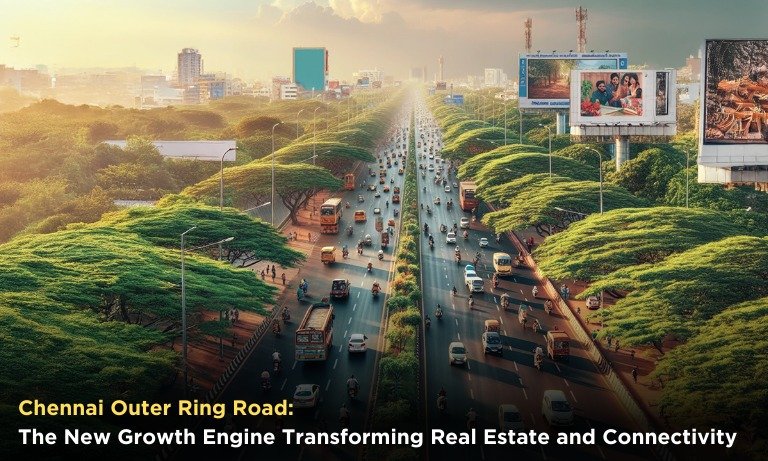Chennai Outer Ring Road: The New Growth Engine Transforming Real Estate and Connectivity

The Chennai Outer Ring Road (ORR), a strategic 62-kilometre infrastructure corridor developed in two phases by the Tamil Nadu government, is redefining the city’s real estate dynamics and urban expansion. Designed to decongest inner-city traffic and streamline connectivity between key urban nodes, the ORR has emerged as a powerful catalyst for residential, commercial, and industrial development. Its impact is being felt across the Chennai Metropolitan Area, as emerging micro-markets, improved transport links, and planned infrastructure upgrades transform how the city grows and functions.
Chennai Outer Ring Road Project: Infrastructure Backbone for a Growing Metropolis
The ORR was executed in two critical phases to establish a seamless, high-capacity transit route on the periphery of Chennai. Phase 1, spanning nearly 29 km, was developed by GMR Infrastructure and includes Segment I, connecting GST Road to NH-48 at Nazarethpettai, and Segment II, linking Nazarethpettai to CTH Road at Nemilichery. Phase 2 extends the corridor by another 33.1 km, connecting Nemilichery to Red Hills (GNT Road), with a project cost of approximately ₹1,075 crore.
This six-lane, access-controlled highway features dedicated service roads on either side, making it both a fast-moving arterial road and a facilitator of local access. The ORR is not just a traffic solution—it’s a foundational platform for regional economic integration and structured urban expansion.
Connectivity and Reduced Travel Time: Redefining Urban Mobility
One of the most immediate and significant impacts of the Outer Ring Road has been the drastic reduction in travel time across Chennai’s periphery. By linking important highways and arterial roads, the ORR enables faster movement between the city’s southern, western, and northern quadrants. This improved connectivity has helped decongest key corridors, reduced vehicular load on inner-city roads, and made daily commutes more predictable for residents and businesses alike.
The ORR has become a vital connector for Chennai’s transport ecosystem, linking the airport, major railway stations, bus terminals, and the city’s industrial belts. The resulting accessibility is drawing more people and enterprises toward the city’s outskirts, driving a wave of decentralized development that aligns with modern urban planning principles.
Residential Real Estate Boom Along the ORR
Enhanced transport infrastructure is often a precursor to real estate growth, and Chennai’s ORR is no exception. The corridor has catalyzed residential development across multiple locations including Poonamallee, Perungudi, Sholinganallur, and Vandalur. These areas are rapidly gaining popularity among homebuyers for their strategic location, improved connectivity to IT and industrial hubs, and availability of relatively affordable housing options.
Integrated townships, gated communities, and large-scale residential projects are now becoming the norm along the ORR. Developers are capitalizing on larger land parcels to create planned communities that include schools, hospitals, commercial zones, and recreational amenities. This evolution marks a shift from unplanned urban sprawl to structured, community-centric development.
Industry reports, including those from platforms like Magic Bricks, consistently list ORR-adjacent localities among Chennai’s top-performing residential micro-markets, thanks to their long-term growth potential and increasing demand from both end-users and investors.
Commercial and Industrial Growth Driving Economic Activity
Beyond residential expansion, the ORR is emerging as a strategic corridor for commercial and industrial development. Its proximity to major national highways, ports, and logistic routes makes it an ideal location for warehousing, logistics, and manufacturing operations. Clusters such as Minjur and Vandalur are being earmarked for development as multi-modal and industrial hubs with dedicated facilities for port-based trade and factory setups.
The Chennai Metropolitan Development Authority (CMDA) has identified several key nodes—such as Poonamallee, Red Hills, and Vandalur—for targeted economic development. These zones are expected to host business parks, IT and ITeS offices, and commercial complexes in the near future. In particular, Poonamallee is attracting attention as a future business district due to its location on the Bengaluru Highway and proposed integration with metro rail extensions.
Urban Planning and Future Development Strategies
To ensure that the growth along the ORR is both inclusive and sustainable, CMDA is rolling out structured urban planning initiatives. These include land pooling schemes, grid-based road formation, and the development of commercial infrastructure along a 50-metre strip on either side of the ORR. Proposals for a dedicated Bus Rapid Transit System (BRTS) are also in the works, aimed at reducing dependence on private vehicles and enhancing last-mile connectivity.
Experts point out that successful urban expansion depends not just on roads, but on a complete ecosystem of utilities and services. This includes reliable electricity, piped water supply, sewage treatment, stormwater drainage, and smart governance. Aligning infrastructure upgrades with land use plans will be critical for unlocking the ORR’s full potential and enhancing quality of life.
North Chennai: A Region Reimagined
Historically perceived as an industrial and working-class zone, North Chennai is undergoing a dramatic transformation, thanks in large part to the ORR. Areas like Madhavaram and Royapuram are witnessing increased demand for premium housing and gated communities. Improved connectivity with the rest of the city—particularly via the ORR and metro expansion—has made these localities attractive to both residents and investors.
The integration of modern residential amenities in these regions is enabling people to live closer to their places of origin without compromising on lifestyle. New residential launches in North Chennai have increased substantially, reflecting not only changing perceptions but also the growing economic importance of the northern corridor.
Complementing Mega Projects: Regional Synergy and Economic Integration
The ORR doesn’t operate in isolation. It complements other significant infrastructure projects, such as the Chennai–Bengaluru Expressway, which promises to further accelerate real estate and economic activity along its alignment. Together, these projects are knitting together regional economies, improving inter-state connectivity, and expanding Chennai’s influence beyond its traditional borders.
This integrated approach to infrastructure and mobility is helping Chennai attract new investments, facilitate trade, and accommodate a rapidly growing population in a planned and efficient manner.
Conclusion: Chennai ORR as the Future Artery of Urban Growth
The Chennai Outer Ring Road has evolved into more than just a traffic decongestion project—it is now a vital artery for urban growth, real estate development, and economic transformation. With enhanced connectivity, growing demand for housing, booming industrial zones, and proactive urban planning, the ORR is laying the groundwork for Chennai’s emergence as a modern, globally competitive metropolis.
As government agencies and private developers continue to invest in infrastructure and land development, the ORR corridor stands poised to become one of South India’s most dynamic growth regions. For homebuyers, investors, and businesses, this presents a timely opportunity to tap into a future-ready market where connectivity, convenience, and community come together.
